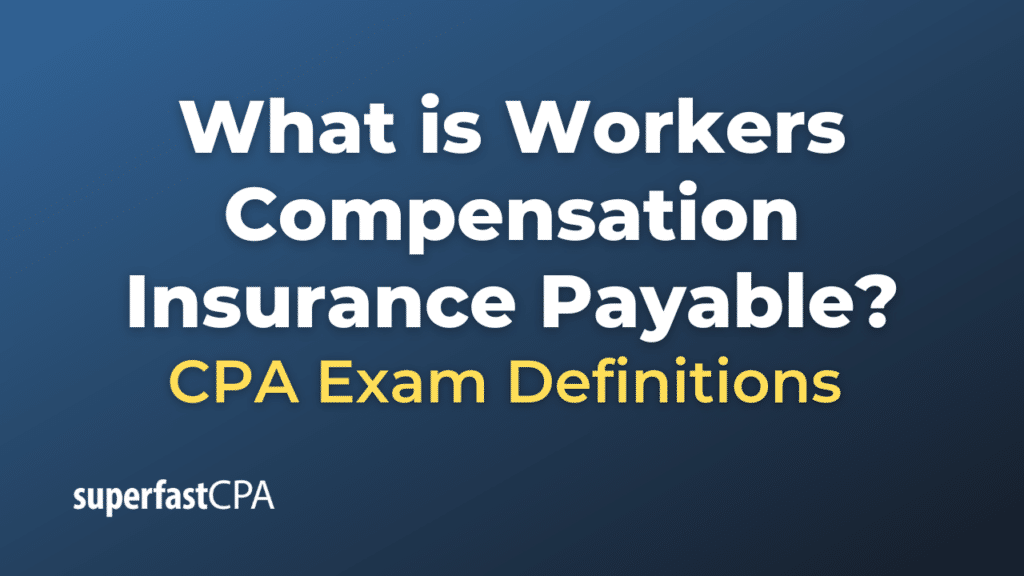Workers Compensation Insurance Payable
Workers’ Compensation Insurance Payable is a liability account that represents the amounts owed by a company for workers’ compensation insurance. This insurance provides wage replacement and medical benefits to employees who are injured while performing their job duties. The liability account reflects the premiums that the company is obligated to pay to an insurance carrier for coverage, as well as any outstanding claims that may not have yet been paid.
The account is generally classified as a current liability on the balance sheet if it is expected to be paid within one year or within the business’s normal operating cycle. If some portion of the amount is not expected to be paid within that period, it could be classified as a long-term liability.
How It Works
- Premium Calculation: At the beginning of the insurance policy period, the insurer estimates the premium based on factors such as the nature of the work, the number of employees, and the historical safety record of the company.
- Accrual: As the company incurs liabilities related to workers’ compensation (either through estimated or actual claims), it records them in the Workers’ Compensation Insurance Payable account.
- Payment: The company pays the insurance premiums as required by the policy, reducing the payable account. Sometimes, adjustments are made at the end of the policy period, depending on the actual experience versus the estimates.
- Claims: When an employee is injured and files a claim, the insurance company will usually cover the claim according to the policy terms. However, until the claim is settled, the estimated liability for that claim may also be included in this payable account.
Example of Workers Compensation Insurance Payable
Here’s a simplified example to illustrate how a Workers’ Compensation Insurance Payable account might work within a company’s accounting records. Let’s assume a fictional company called “HandyFix,” which provides home repair services.
HandyFix has an annual workers’ compensation insurance premium of $12,000, payable quarterly. During the first quarter, one of its carpenters is injured on the job, and it is estimated that the claim will cost $5,000.
Journal Entries:
1. Accruing the Quarterly Insurance Premium:
At the end of the first quarter, HandyFix needs to record its insurance liability for that quarter.
Debit: Insurance Expense $3,000
Credit: Workers' Compensation Insurance Payable $3,000 This entry records the $3,000 quarterly premium as an expense and shows that HandyFix has a liability to pay this amount to the insurance company.
2. Paying the Quarterly Premium:
When HandyFix pays the $3,000 premium to the insurance company, it will make the following journal entry:
Debit: Workers' Compensation Insurance Payable $3,000
Credit: Cash $3,000 This entry removes the liability from the payable account and decreases the company’s cash.
3. Recording the Estimated Claim Liability:
After the carpenter’s accident, HandyFix estimates that the claim will cost $5,000. The following journal entry is made:
Debit: Insurance Expense $5,000
Credit: Workers' Compensation Insurance Payable $5,000 This entry recognizes the estimated cost of the worker’s compensation claim as an additional insurance expense and increases the payable account to reflect this new liability.
4. Settlement of the Claim:
Let’s assume the claim is settled and the insurance company confirms it will cover the $5,000 claim. The journal entry would remain as it is, as the estimate was accurate.
However, if the claim is settled for a different amount, say $4,500, an adjustment needs to be made:
Debit: Workers' Compensation Insurance Payable $500
Credit: Insurance Expense $500 This entry adjusts the expense and payable accounts to reflect the actual cost of the claim, which turned out to be $500 less than initially estimated.
In summary, the Workers’ Compensation Insurance Payable account is used to track both the premiums owed to the insurance company and any outstanding or estimated claims for work-related injuries. This ensures that the company accurately reflects its financial obligations related to workers’ compensation.












